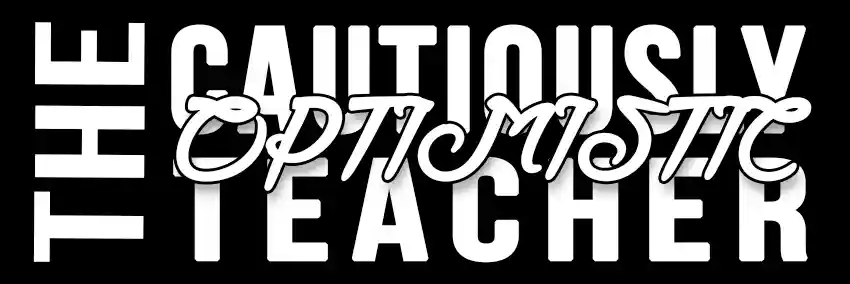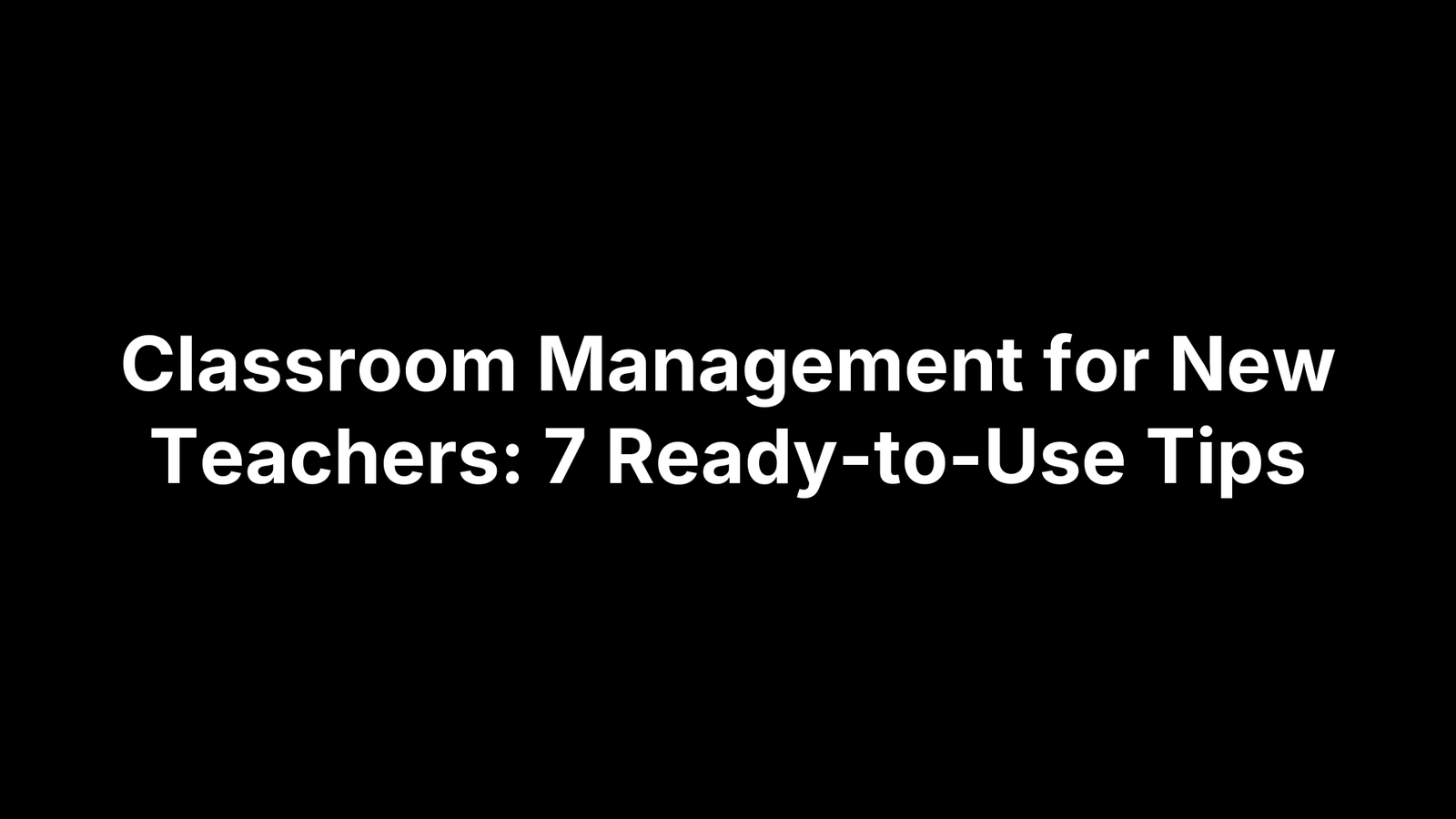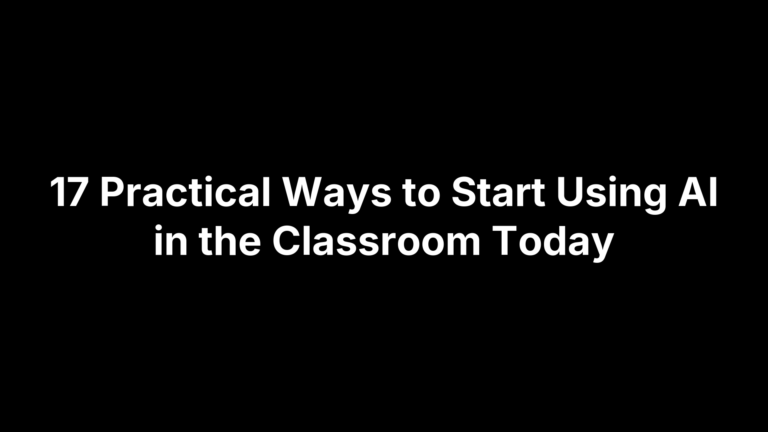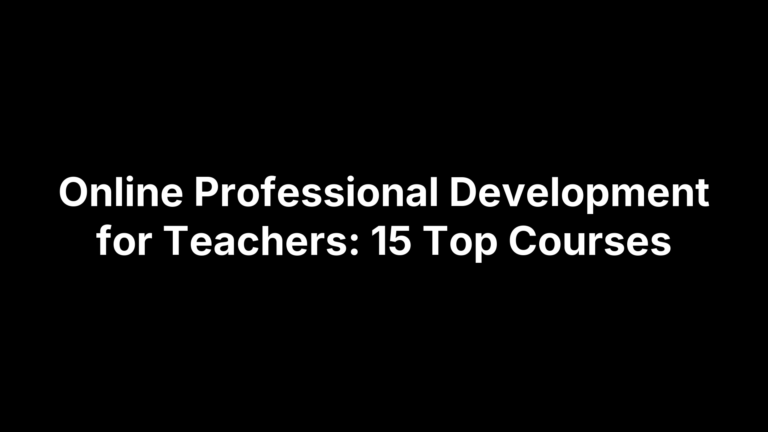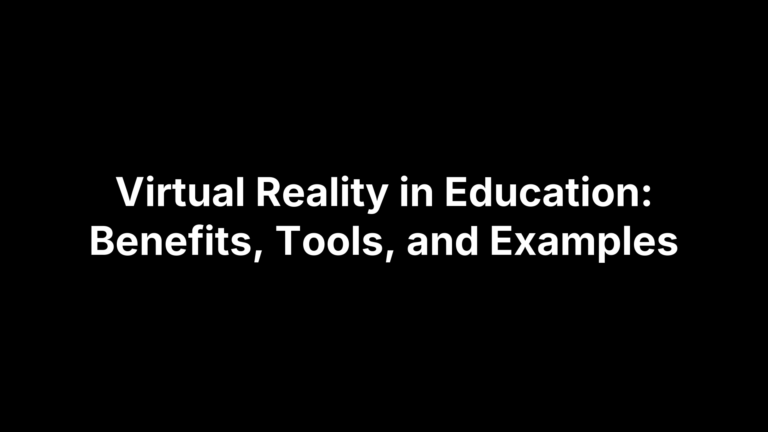Classroom Management for New Teachers: 7 Ready-to-Use Tips
Your first day of teaching is hours away and your mind races with questions. What happens when students talk over you? How do you handle a student who refuses to follow directions? Should you smile and be friendly or start strict? These questions keep new teachers up at night because classroom management often feels like the secret skill nobody taught you in college.
Here’s the truth: effective classroom management isn’t about having the loudest voice or the strictest rules. It’s about creating systems that prevent problems before they start and building an environment where students want to learn. This article walks you through seven practical strategies you can implement tomorrow. Each tip includes specific steps to follow, explains why it works, and shows you how to avoid common mistakes that trip up beginners. You’ll learn how to set expectations students actually follow, build routines that save time, keep kids engaged, and respond to behavior in ways that strengthen your classroom instead of creating power struggles.
1. Use The Cautiously Optimistic Teacher tools
You don’t need to reinvent the wheel when better tools already exist. The Cautiously Optimistic Teacher offers AI-powered resources specifically designed to solve the time-consuming tasks that drain new teachers. These tools handle the heavy lifting of differentiated instruction, worksheet creation, and assessment feedback so you can focus on what matters most: managing your classroom and building relationships with students.
Why this supports classroom management
Strong classroom management for new teachers starts with preparation that doesn’t overwhelm you. When you spend three hours creating worksheets or another two hours writing report card comments, you have less energy for planning engaging lessons and responding thoughtfully to student behavior. The platform’s AI tools eliminate this drain by generating customized materials in minutes. You arrive at school refreshed instead of exhausted, which directly impacts how you handle classroom challenges throughout the day.
Teachers who feel prepared and rested respond to disruptions with patience rather than frustration.
Steps to implement as a new teacher
Start with the Differentiated Instruction Helper when you notice students working at different levels. Input your lesson objective and let the tool suggest three tiered activities that keep all students engaged. Use the Question Generator to create discussion prompts from your reading material, ensuring you have thoughtful questions ready when students finish early or need extension work. The Worksheet Maker transforms your vocabulary lists or practice problems into professional materials without the formatting headache.
Common pitfalls and how to avoid them
New teachers often resist technology tools because they feel they should do everything manually to prove themselves. This mindset leads to burnout within the first semester. Use these tools strategically for routine tasks while saving your creative energy for lesson design and student interaction. Another mistake is generating materials without reviewing them first. Always preview AI-generated content to ensure it matches your classroom needs and teaching style.
2. Set clear expectations from day one
Students cannot meet expectations they don’t understand. Your classroom runs smoothly when you define exactly what you want and teach those behaviors explicitly before problems arise. This means establishing rules, procedures, and academic standards during the first week and revisiting them consistently. Clear expectations eliminate confusion about what success looks like in your room, whether you’re discussing how to enter the classroom, ask questions, or complete assignments.
Why this supports classroom management
Ambiguity creates chaos because students fill the void with their own interpretations of acceptable behavior. When you establish non-negotiable boundaries at the start, students feel secure knowing exactly where the lines exist. Research shows classrooms with clearly defined expectations experience fewer disruptions and higher engagement because students spend less time guessing what you want and more time learning. Explicit expectations also protect you from accusations of unfairness since every student receives the same information about your standards.
Students thrive when they understand the rules of the game before play begins.
Steps to implement as a new teacher
Spend your first class period teaching three to five core rules that cover most situations rather than creating an overwhelming list of restrictions. Frame expectations positively by stating what students should do instead of what they shouldn’t do. Model each expectation through demonstration and practice, such as showing students how to transition between activities or submit work properly. Create a visual reference like a poster or handout that students can consult throughout the year. Revisit expectations after long breaks when students need reminders about your classroom systems.
Common pitfalls and how to avoid them
New teachers often announce rules once and assume students remember them forever. Classroom management for new teachers improves dramatically when you reteach expectations regularly during the first month until behaviors become automatic. Another mistake is creating too many rules that you can’t possibly enforce consistently. Focus on essential expectations that directly impact learning and safety. Avoid vague language like "be respectful" without defining what respect looks like in specific situations, such as during partner work or class discussions.
3. Build predictable routines and transitions
Students waste precious learning time when they constantly ask what comes next or wait for instructions during transitions. Predictable routines eliminate this confusion by automating the flow of your classroom. When students know exactly what to do when they enter, how to get materials, when to turn in work, and how to transition between activities, you reclaim 10 to 15 minutes of instructional time every single day. This structure creates a calm environment where students move smoothly through the day instead of creating bottlenecks that lead to behavior problems.
Why this supports classroom management
Transitions represent the most vulnerable moments in your classroom because unstructured time invites disruption. Students who finish tasks early or wait for instructions naturally fill that void with off-task behavior, side conversations, or restlessness. Established routines solve this problem by giving students automatic next steps that require no teacher direction. When entering the room becomes an automatic process of grabbing materials, checking the board for instructions, and starting the warm-up activity, you eliminate the chaos of 20 students simultaneously asking what to do. Routines also reduce your cognitive load since you don’t need to micromanage every movement or decision.
Predictable structures free your attention to address student needs instead of managing logistics.
Steps to implement as a new teacher
Identify the five most common transitions in your day, such as entering the room, moving to group work, submitting assignments, getting supplies, and packing up. Create a specific procedure for each transition and write it down so you teach it consistently. Practice each routine with students through physical rehearsal rather than just verbal explanation. For example, actually have students walk through how to collect materials, return to seats, and begin work. Use visual cues like timers, hand signals, or music to mark transition beginnings and endings. Post procedures in visible locations so students can reference them independently.
Common pitfalls and how to avoid them
New teachers often assume students already know basic classroom procedures from previous years, but every teacher runs their room differently. Classroom management for new teachers improves when you explicitly teach every routine you want students to follow, even if it seems obvious. Another mistake is creating elaborate procedures that you can’t maintain consistently. Choose simple, repeatable systems that work even on your most exhausted days. Avoid abandoning routines when students resist initially, as consistency builds habits that eventually become automatic.
4. Build relationships and classroom community
Students respond to teachers they trust and respect, not teachers they fear. Building genuine relationships transforms your classroom from a collection of individuals into a community where students feel safe taking risks, asking questions, and supporting each other. This foundation of connection makes every other management strategy more effective because students naturally want to meet expectations for someone who knows and values them as individuals.
Why this supports classroom management
Behavioral issues decrease dramatically when students feel personally connected to their teacher. Research shows students who believe their teacher cares about them demonstrate higher engagement and fewer disruptions because they don’t want to disappoint someone who invested in knowing them. Strong relationships also give you credibility when you need to address problems, as students accept feedback from teachers who have built trust through consistent positive interactions. When students feel part of a community rather than isolated individuals, they hold themselves and each other accountable to group norms.
Students who feel valued by their teacher choose cooperation over defiance.
Steps to implement as a new teacher
Learn student names within the first week by using name tents, seating charts with photos, or name games that create opportunities for repeated exposure. Greet students at the door with eye contact and a personal comment about their interests, weekend plans, or recent accomplishments. Dedicate the first 10 minutes of class once weekly to community-building activities like partner interviews, goal sharing, or collaborative challenges that aren’t academic. Show genuine curiosity about student lives by asking follow-up questions when they share information and remembering details for future conversations.
Common pitfalls and how to avoid them
New teachers sometimes confuse building relationships with being overly friendly or permissive, which undermines authority. Classroom management for new teachers succeeds when you maintain warm but firm boundaries where students feel cared for without viewing you as a peer. Another mistake is only investing in relationships with compliant students while ignoring challenging ones. Difficult students often need connection most, so intentionally seek positive interactions with students who test limits to build relationships before conflicts arise.
5. Keep students engaged and moving
Students who sit still for extended periods naturally become restless, distracted, and prone to disruption. Your classroom management improves dramatically when you incorporate movement and varied activities that match how young brains actually function. Research shows that physical activity increases blood flow to the brain, which enhances focus, memory, and learning capacity. When you build movement into your lessons rather than fighting against students’ natural need to move, you prevent behavior problems before they start. This strategy works across all grade levels because the human body simply wasn’t designed for prolonged stillness.
Why this supports classroom management
Movement breaks interrupt the boredom that fuels misbehavior during long stretches of passive learning. Students who spend 30 to 40 minutes sitting and listening begin fidgeting, chatting with neighbors, or zoning out completely. Incorporating physical activity resets their attention spans and gives their bodies a productive outlet for energy that would otherwise manifest as disruption. Active learning strategies also increase engagement because students process information more deeply when they move, discuss, and interact rather than passively receiving content.
Physical engagement transforms potential disruption into productive learning energy.
Steps to implement as a new teacher
Plan intentional movement breaks every 15 to 20 minutes by using strategies like four corners discussions, gallery walks, or partner consultations that require students to physically relocate. Incorporate kinesthetic learning activities such as acting out vocabulary words, creating human timelines, or demonstrating concepts through movement. Use brain breaks like stretching routines, quick games, or dance movements when you notice energy levels dropping or attention wandering. Structure lessons with alternating segments of sitting and moving so students anticipate regular opportunities to leave their seats.
Common pitfalls and how to avoid them
New teachers worry that movement creates chaos they can’t control, so they keep students seated and wonder why behavior deteriorates. Classroom management for new teachers strengthens when you embrace structured movement as a prevention tool rather than avoiding it from fear. Another mistake is allowing movement activities to drag beyond their purpose. Keep transitions tight and time-limited with clear signals for when movement begins and ends, ensuring activities refocus students rather than energizing disruption.
6. Use positive, consistent responses to behavior
Your response to student behavior determines whether problems escalate or resolve quickly. Reacting with positive reinforcement and consistent consequences builds a classroom where students understand exactly what behaviors earn praise and what actions trigger corrections. This approach prevents the exhausting cycle of power struggles that drain your energy and create tension with students. When you catch students following expectations and acknowledge their effort publicly, you teach the entire class what success looks like through concrete examples rather than abstract rules.
Why this supports classroom management
Positive responses outweigh negative consequences in effective classrooms because students repeat behaviors that earn recognition. Research shows classrooms where teachers deliver five positive interactions for every correction experience significantly fewer disruptions because students seek teacher approval through cooperation. Consistency matters equally because students test boundaries when they see rules applied selectively. When you enforce expectations uniformly regardless of which student breaks them or what mood you’re in, students stop challenging your authority because they trust your predictability.
Students who trust your consistency stop testing boundaries and start following expectations automatically.
Steps to implement as a new teacher
Actively scan your classroom for students following directions and specifically name what they’re doing right, such as "I notice Marcus started the assignment immediately without waiting for reminders." Use a 2-to-1 ratio of praise to correction minimum to maintain a positive classroom climate. Establish consequences for rule violations before school starts so you respond calmly rather than creating punishments in anger. Apply corrections privately and briefly by using proximity, quiet redirections, or quick conferences instead of public call-outs that embarrass students and create defensiveness.
Common pitfalls and how to avoid them
New teachers often only provide feedback when students misbehave, creating classrooms where negative attention becomes the norm. Classroom management for new teachers succeeds when you intentionally seek positive behaviors to acknowledge throughout each lesson. Another mistake is inconsistent enforcement where you ignore small disruptions until frustration explodes into disproportionate consequences. Address minor issues immediately with gentle corrections to prevent escalation, maintaining the same standards every single day regardless of your stress level.
Bringing it together
These seven strategies work as an interconnected system rather than isolated techniques. When you use The Cautiously Optimistic Teacher tools to save time on preparation, you gain energy for building relationships. Clear expectations and predictable routines create the structure that allows movement and engagement to flourish without chaos. Positive responses to behavior strengthen the community you’ve built, while that community makes students more receptive to your expectations.
Success with classroom management for new teachers doesn’t require perfection from day one. You’ll refine these strategies throughout your first year as you learn what works with your specific students and teaching style. Start with the one or two techniques that address your biggest challenges right now, then gradually layer in additional strategies as you gain confidence.
Ready to simplify your classroom preparation? Explore more teacher resources and tools that support effective classroom management and help you focus on what matters most: teaching students who feel valued, engaged, and ready to learn.
